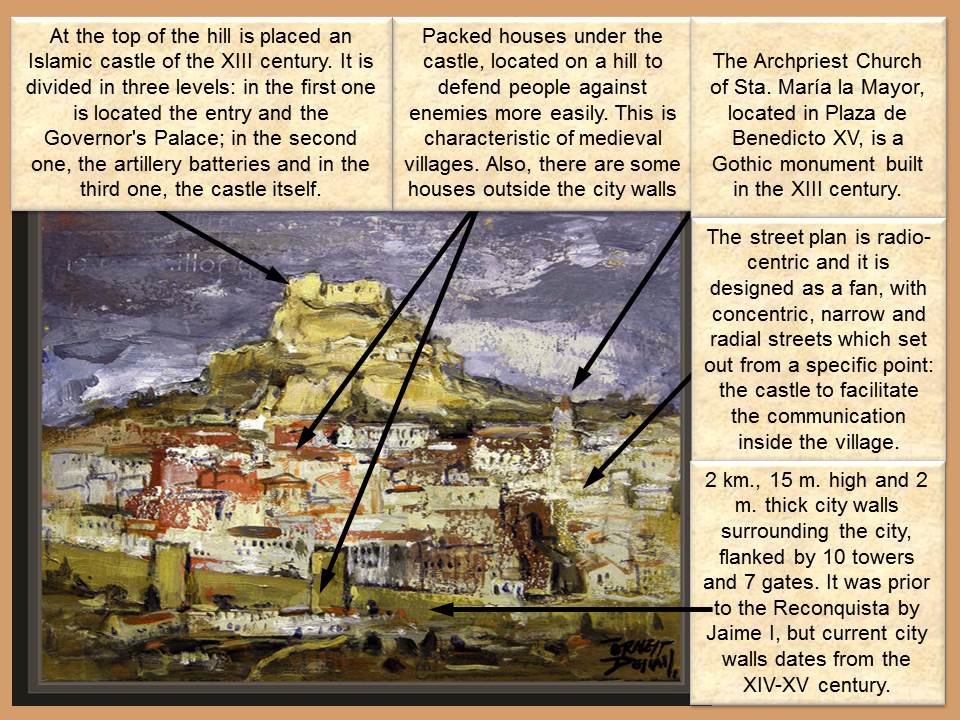This work of art was made by Ernest Descals and has been taken from his official website ErnestDescals’sBlog. This painter was born on 13 January 1956 in Manresa. From his childhood he marveled at the drawings, paintings, illustrations and photographs, due to the great influence of his family. This painting represents a partial urban perspective of the Spanish village of Morella nowadays and it is made in oil and collage. It is characterized by the representation of the landscape outdoor in a spontaneous way, centered in the natural light effects, blurring the outlines and eliminating the details. In this case, the use of cold and dark colors is predominant.
Morella is a medieval village that one can visit in the region of Maestrazgo in the North of the province of Castellón (Comunidad Autónoma de Valencia). It is located over the hill “La Mola” about 1,000 meters high and next to the river Bergantes. These two geographical features were very important along its history because they were natural defenses. Due to its strategic position, this village was difficult to besiege and easy to defend. In those times villages were placed next to the rivers in order to get water effortlessly. The river Bergantes provides means of livelihood through the agriculture, fishing and livestock.
In the picture, one may distinguish a radio centric town planning, organized around a central point which is characteristic of medieval villages. The street system is designed as a fan, with concentric and radial streets that set out from a specific point -the castle- to facilitate the communication inside the village. Moreover, the layout had to adjust to the difficulties and irregularities of the topography, so the streets are quite narrow, irregular and winding. High streets start from the center and extend in a radial way to the gates of the city walls. Besides, back streets connect radial streets, forming a circle around the center. As a result, the perimeter is substantially circular, facilitating the defense.
The paint displays a very clear structure, divided in three levels. At the top of the picture one may observe a huge and imposing castle where, in me Middle Ages, the feudal lord resided with his wealth. In the center, under the castle, we can find the village with a packed housing in which peasants lived. Also, we can appreciate some religious buildings destined for clergy. Finally, outside of the city walls we distinguish some houses. Based on this composition one comes to the conclusion that the society of this time was hierarchically organized but very well protected because the village was built inside a city walls.
As a consequence of their favorable position for the attack and defense, Morella was a village very reclaimed along history: Greeks, Romans, Visigoths, Muslims… The most important and famous battle occurred in this village was the Battle of Morella, during the Muslim domination, whose protagonist was Rodrigo Díaz de Vivar, El Cid. Afterwards, King Alfonso I retook Morella for the Christians and, for the second time, Jaime I in the XIII century, expelled the Arabs.
Currently, Morella’s economy is based on the tertiary sector, driven by internal and external tourism. The textile industry is the commercial center of the region but, in last decade, due to its favorable conditions of wind circulation, some wind farms have been developed. Moreover, thanks to the fields surrounding the village, agriculture and livestock (pigs and poultry) complement his business.
Finally, in this work of art we can identify some significant monuments, such as the Arch-priest Gothic Basilica of Sta. María Mayor (XIII- XIV centuries) on the right of the painting, and the Monastery of St. Francisco that was home to Franciscan friars. In addition, the most notable civil buildings are the castle of three levels, built in XIII century. Also, the medieval walls, built mostly by Pedro IV de Aragón between the XIV and XV centuries, are related to the defensive function of the city. Although it is not represented in this paint, around Morella there is a gothic aqueduct very well conserved.
María Alba Parra.

